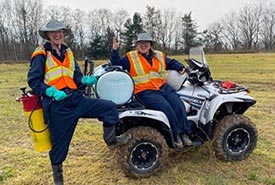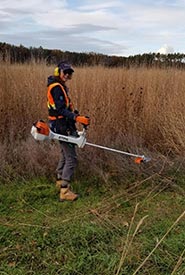NCC: Land Lines – Connecting to conservation

Allery Safruk and Mena Wallace, volunteer conservation interns and CCC participants, conducting invasive species control. (Photo by NCC)
Collaboration for conservation
The Nature Conservancy of Canada (NCC) is one of many partnership organizations holding 12-week placements for a number of lucky Canadian Conservation Corps (CCC) participants — me included! The placement opportunities are in many different areas of conservation, including helping with invasive species control, habitat management, trail maintenance, landowner engagement and stewardship, assisting with species at risk research projects and building project infrastructure.
The Canadian Wildlife Federation facilitates the CCC program for Canadian youth aged 18 to 30. The program is aimed at connecting and inspiring like-minded individuals with conservation initiatives across the country. This three-part, nine-month program provides an exciting opportunity for youth to learn, inspire and experience Canada in a unique way while having an impact on conservation. The opportunity begins with an exciting wilderness adventure, followed by a field work placement with leading conservation organizations. The last stage of the program gives participants a chance to develop their own ideas into a meaningful service project for their communities. The CCC’s goal is to mobilize youth with the tools, experience and connections needed to inspire others on a life-long mission to care for our planet’s species and natural environments.
I joined the Canadian Conservation Corps, as I wanted to learn more about conservation issues across Canada and gain the skills to help make a difference, all while networking with national organizations and like-minded youth. As a Manitoban who had not yet explored many other areas of Canada, my placement with the Nature Conservancy of Canada in Norfolk County has allowed me to see the province of Ontario in a brilliant new light. During my time with NCC, I am not only learning all about the amazing areas within the Carolinian Life Zone (did you know that this zone covers only one per cent of Canada’s land area, but is home to 25 per cent of Canada’s species at risk?) but also how to help restore wetlands in this richly biodiverse area and help some of the incredible species that are found only here!
Hands-on experience

Allery Safruk conducting conifer control in restored open habitat. (Photo by NCC)
One of my favourite ongoing projects that I’ve been involved with is invasive species control. Phragmites (or common reed) is one of Canada’s worst invasive plants. I have been enjoying the satisfying process of learning to identify and eradicate phragmites from wetland areas on NCC properties across Norfolk County. I have also learned to identify and manage autumn olive, multiflora rose and black locust, which are woody-stemmed invasive species found on the restored properties. It feels incredibly rewarding to be out on the land, helping ensure native species have the habitats they need to flourish.
And this is only the beginning! I can’t wait to see what else my time with the Nature Conservancy of Canada and the Canadian Conservation Corps holds!




